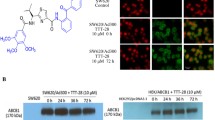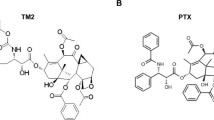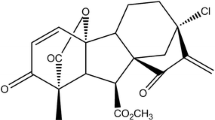Abstract
Purpose
To investigate the reversal mechanisms of a novel semisynthetic taxane derivative, Syl611. Syl611 is a structurally modified compound from Sinenxan A, and the chemical structure is entirely new. It was found to significantly increase paclitaxel-induced cytotoxicity in drug-resistant cells, while presenting a low level of cytotoxicity.
Methods
The in vitro cytotoxic and MDR-reversing activities of the Syl611 were determined by MTT assays. The cytotoxicity enhancement of paclitaxel was performed using the acridine orange/ethidium bromide double staining. Rhodamine 123 accumulation and retention assay in KB/V cells, Caco-2 monolayer model were used to find mechanism of action.
Results
The cytotoxicity of Syl611 was wondrously lower in all tested cell lines than that of paclitaxel. Cytotoxicity enhancement from Syl611 was dramatically higher than that of verapamil of the same concentration (10 μM): the reversal fold index for A549/Paclitaxel, KB/V, and Bel7402/5-FU were 45.95, 73.56, and 107.13 (Syl611) and 11.36, 23.92, and 70.42 (verapamil). AO/EB double staining assay equally showed that Syl611 could enhance the cytotoxicity induced by paclitaxel. Furthermore, Syl611 could also increase the intracellular accumulation of Rhodamine 123 in KB/V cells without affecting P-gp’s expression, and this accumulation was reversible. In bidirectional permeability assay, Syl611 increased the permeability of paclitaxel but decreased the net secretory of paclitaxel.
Conclusions
Syl611 is an effective and potential agent in reversing multidrug resistance (MDR) by multiple actions, which attributed to p-glycoprotein inhibition and drug permeability enhancement.






Similar content being viewed by others
References
Higgins CF (2007) Multiple molecular mechanisms for multidrug resistance transporters. Nature 446:749–757
Nooter K, Stoter G (1996) Molecular mechanisms of multidrug resistance in cancer chemotherapy. Pathol Res Pract 192:768–780
Gottesman MM, Fojo T, Bates SE (2002) Multidrug resistance in cancer: role of ATP-dependent transporters. Nat Rev Cancer 2:48–58
Kimura Y, Matsuo M, Takahashi K, Saeki T, Kioka N, Amachi T, Ueda K (2004) ATP hydrolysis-dependent multidrug efflux transporter: MDR1/P-glycoprotein. Curr Drug Metab 5:1–10
Tsuruo T, Iida H, Tsukagoshi S, Sakurai Y (1981) Overcoming of vincristine resistance in P388 leukemia in vivo and in vitro through enhanced cytotoxicity of vincristine and vinblastine by verapamil. Cancer Res 41:1967–1972
Couture L, Nash JA, Turgeon J (2006) The ATP-binding cassette transporters and their implication in drug disposition: a special look at the heart. Pharmacol Rev 58:244–258
Cnubben NH, Wortelboer HM, van Zanden JJ, Rietjens IM, van Bladeren PJ (2005) Metabolism of ATP-binding cassette drug transporter inhibitors: complicating factor for multidrug resistance. Expert Opin Drug Metab Toxicol 1:219–232
Thomas H, Coley HM (2003) Overcoming multidrug resistance in cancer: an update on the clinical strategy of inhibiting p-glycoprotein. Cancer Control 10:159–165
Rowinsky EK, Onetto N, Canetta RM, Arbuck SG (1992) Taxol: the first of the taxanes, an important new class of antitumor agents. Semin Oncol 19:646–662
Sparreboom A, van Asperen J, Mayer U, Schinkel AH, Smit JW, Meijer DK, Borst P, Nooijen WJ, Beijnen JH, van Tellingen O (2007) Limited oral bioavailability and active epithelial excretion of paclitaxel (Taxol) caused by P-glycoprotein in the intestine. Proc Natl Acad Sci USA 94:2031–2035
Geney R, Ungureanu M, Li D, Ojima I (2002) Overcoming multidrug resistance in taxane chemotherapy. Clin Chem Lab Med 40:918–925
Dai J, Yang L, Sakai J, Ando M (2005) A taxa-tetraene from microbial transformation of sinenxan A. Chin Chem Lett 6:736–738
Du H, Zhang M, Yin D (2007) Synthesis and biological evaluation of new 4-deacetyl-1, 7, 9-trideoxy-10-oxopaclitaxel via Sinenxan A. Synth Commun 37:3779–3791
Zhang M, Yin D, Guo J-Y, Liang X-T (2005) Synthesis of 7, 9-dideoxybaccatin IV analogs from sinenxan A. Tetrahedron 61:5519–5527
Jin J, Huang M, Wei HL, Liu GT (2002) Mechanism of 5-fluorouracil required resistance in human hepatocellular carcinoma cell line Bel(7402). World J Gastroenterol 8:1029–1034
Zhang XH, Zhang FY, Ji XJ, Li ZY (1994) Vincristine resistant human KB cell line and mechanism of multidrug resistance. Yao Xue Xue Bao 29:246–251
Hotz MA, Gong J, Traganos F (1994) Flow cytometric detection of apoptosis comparison of the assays of in situ DNA degradation and chromatin changes. Cytometry 15:237–244
Chong S, Dando S, Soucek K, Morrison R (1996) In vitro permeability through Caco-2 cells is not quantitatively predictive of in vivo absorption for peptide-like drugs absorbed via the dipeptide transporter system. Pharm Res 13:120–123
Willey TA, Bekos EJ, Gaver RC, Duncan GF, Tay LK, Beijnen JH, Farmen RH (1993) High-performance liquid chromatographic procedure for the quantitative determination of paclitaxel (Taxol) in human plasma. J Chromatogr 621:231–238
Parness J, Horwitz SB (1981) Taxol binds to polymerized tubulin in vitro. J Cell Biol 91:479–487
Brooks TA, Minderman H, O’Loughlin KL, Ojima I, Baer MR, Bernacki RJ (2003) Taxane-based reversal agent modulation of P-glycoprotein-, multidrug resistance protein- and breast cancer resistance protein-mediated drug transport. Mol Cancer Ther 2:1195–1205
Ojima I, Borella CP, Wu X, Bounaud P-Y, Fumero C, Sturm M, Miller ML, Chakravarty S, Chen J, Huang Q, Pera P, Brooks TA, Baer MR, Bernacki R (2005) Design, synthesis and SAR of novel taxane-based multi-drug resistance reversal agents. J Med Chem 48:2218–2228
Acknowledgments
We thank Dr. Xuguang Zheng and Christopher Shih for critical reading of this paper. This study was supported by the National Natural Science Key Foundation (Grant No.30630069)
Author information
Authors and Affiliations
Corresponding author
Rights and permissions
About this article
Cite this article
Zhang, Y., Li, H., Wang, H. et al. Syl611, a novel semisynthetic taxane derivative, reverses multidrug resistance by p-glycoprotein inhibition and facilitating inward transmembrane action. Cancer Chemother Pharmacol 66, 851–859 (2010). https://doi.org/10.1007/s00280-009-1229-9
Received:
Accepted:
Published:
Issue Date:
DOI: https://doi.org/10.1007/s00280-009-1229-9




